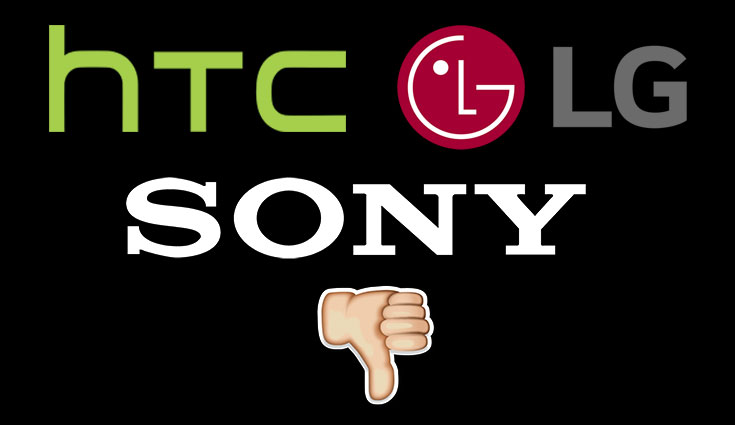There was a time when companies like HTC, LG, and Sony used to be leaders in the Android smartphone market. It was a time when brand loyalty was truly strong, and their reputations preceded their launches. However, things have taken a 360-degree turn and today, we see significantly less demand for HTC, Sony or even LG smartphones. One major factor here is the entry of Chinese OEMs like Xiaomi and OnePlus, which have not only grabbed a large chunk of sales volume from these tier-1 giants but also served notice to these firms about the new rules in the Indian smartphone market. People in India are highly priced sensitive and always look for best value for money product in the market. So while HTC, Sony and LG delivered on the quality side, the following factors have ensured they are unable to build on those solid reputations.
Price
When buying a smartphone in the Indian market, a customer is always concerned about the price. No matter what technology advancements and innovations have been implemented in your product, if it is not priced right, it will not sell in India. This is exactly what HTC, Sony, and LG failed to learn over these past few years. Talking about HTC first, the Taiwanese handset manufacturer made a grand comeback with its HTC One M7 back in the year 2013. However, since then the graph has been continuously sloping down. The major reason behind this? Price. HTC is known to charge a fair premium for its smartphones and for the most part, people have not had problems. However, some recent launches from the company indicate an overtly optimistic view o the premium the brand can command. Talking about thr latest launch, the HTC U Ultra is priced at Rs 59,990 and the HTC U Play is priced at Rs 39,990. We are not denying that the U Ultra is not a good smartphone, but when we have Google Pixel selling for under Rs 50K (with cashback offers), why would anyone buy an HTC smartphone with similar specifications? Not to forget, we still have OnePlus 3T which has near identical specifications to the U Ultra and is sold for exactly half the price. In fact, perhaps rarely has a single firm made as much an impact for improving perceptions of Chinese quality as One Plus, and before that, Xiaomi. This has considerably narrowed the possible premium the Taiwanese firm should charge, something they seem to be unable to acknowledge right now.
Similarly, Sony Xperia X was launched for a price of Rs 48,990 with a Qualcomm Snapdragon 650 chipset. Note that, Xiaomi Redmi Note 3 which was priced around Rs 10,000 has the same Chipset inside. And things doesn’t necessarily improve for LG as in December last month, the South Korean giant launched its V20 smartphone at Rs 54,999. In other words, LG, Sony, and HTC are really struggling to get the pricing right (in the first go) in India.
Delayed Launch and Availability
Another cause for this recent decline in smartphones from these companies has been delayed availability. While companies like OnePlus, Lenovo and even Xiaomi (in some cases) prioritise India as their one of the most important markets, companies like Sony, LG, and HTC are just not up in this game with other manufacturers. Even Google launched its Pixel and Pixel XL smartphones in India sooner than expected. Taking an example, LG launched its LG V20 more than 4 months after it was officially unveiled in the United States. Same goes for smartphones from HTC including the Desire 10 Pro and HTC 10 Evo. Launching a smartphone at the right time in the right market plays a major role in its success. Samsung never fails to impress Indian audience, in this aspect. The company always targets Indian audience for most of its smartphones and is resultingly doing much better than HTC, Sony or LG in this department.
Visibility
Delayed launch is just one wheel to this car of continuous failures. Visibility is another factor where these companies have been struggling lately. To cite an example, how many of us saw any kind of advertising for the LG V20? In our opinion, LG V20 was a decent smartphone with some really unique functionalities in the name removable battery, dual cameras and dual screen up front, however, LG failed to take the LG V20 to its customers. Similarly, HTC did the exact same thing with HTC 10 Evo which was announced back in November 2016 but was made available recently. However, Sony has been relatively better in this area but it struggles with a definitive portfolio of smartphones. In other words, the Japanese multinational introduce a new series of smartphones every year making it confusing for customers to spot the right choice for them.
What should HTC, LG, and Sony do?
To improve the current situation, these companies need to possibly stop Benchmarking their marketing strategies with Apple in their sights. Playing in the Android market, they need to acknowledge that weaning Apple fans is not what they really should be looking at. It is all about consolidating the premium Android buyers with their offerings. And when it comes to Androids, a key reason to buy is the hope for comparable features at a smarter price. It’s time we see flagships from HTC, LG and even Sony enter the Indian market at the right time. Otherwise, Samsung will again look to capture plenty of sales volume which otherwise could have been shared between any of these companies. Lastly, these companies should really work on the advertising strategy. Chinese companies such as Vivo and Oppo are banking heavily on advertising and to some extent, it is reaping fruits for them. HTC, LG, and to an extent Sony being pretty well-established names have probably held back too hard on promotions. Time to correct the mistake.


